Effect of Transient Creep on the Structural Performance of Reinforced Concrete Walls under Fire
Abstract
1. Introduction
2. Modeling
3. Numerical Example
3.1. Effect on a RC Wall with Little Spalling
3.2. Effect on a RC Wall with Explosive Spalling
4. Model Validation
5. Parametric Studies
5.1. RC Walls with Little Spalling
5.1.1. Effect of Wall Thickness
5.1.2. Effect of Wall Height
5.1.3. Effect of Concrete Strength
5.1.4. Effect of Eccentricity of Load
5.2. RC Walls with Explosive Spalling
5.2.1. Effect of Wall Thickness
5.2.2. Effect of Wall Height
5.2.3. Effect of Intrinsic Permeability of Concrete
5.2.4. Effect of Eccentricity of Load
6. Conclusions
- The transient creep has a notable effect on the structural deformations of RC walls under fire even without load. The transient creep significantly reduces the fire resistance of RC walls with little spalling, and the effect increases with the increasing load level and/or the increasing eccentricity of load.
- The transient creep delays the occurrence, reduces the rate of explosive spalling, and increases the fire resistance of RC walls with explosive spalling. The stress relaxation effect of transient creep has a crucial role in determining the spalling manner, and it mitigates the variation in spalling along the wall height.
- The influence of the transient creep on the fire resistance of RC walls with little spalling increases with the decreasing wall thickness and/or the increasing wall height, while the effect decreases with the similar changes for RC walls with explosive spalling. The variation in the intrinsic permeability of concrete can have an effect on the influence of transient creep on the fire resistance of RC walls.
- The high thermal mass of concrete and the low permeability of high-strength concrete are the key factors leading to the transient creep’s significant influence on the fire resistance of RC walls.
Funding
Data Availability Statement
Conflicts of Interest
References
- Aslani, F.; Bastami, M. Constitutive relationships for normal- and high-strength concrete at elevated temperatures. ACI Mater. J. 2011, 108, 355–364. [Google Scholar]
- CEN EN 1992-1-2; Eurocode 2: Design of Concrete Structures—Part 1–2: General Rules—Structural Fire Design. European Committee for Standardization (CEN): Brussels, Belgium, 2004.
- Kodur, V.; Phan, L. Critical factors governing the fire performance of high strength concrete systems. Fire Saf. J. 2007, 42, 482–488. [Google Scholar] [CrossRef]
- Mehta, P.; Monteiro, P. Concrete: Microstructure, Properties, and Materials; McGraw-Hill: New York, NY, USA, 2006. [Google Scholar]
- Khoury, G.; Grainger, B.; Sullivan, P. Transient thermal strain of concrete: Literature review, conditions within specimen and behaviour of individual constituents. Mag. Concr. Res. 1985, 37, 131–144. [Google Scholar] [CrossRef]
- Sadaoui, A.; Khennane, A. Effect of transient creep on the behavior of reinforced concrete columns in fire. Eng. Struct. 2009, 31, 2203–2208. [Google Scholar] [CrossRef]
- Kodur, V.; Alogla, S. Effect of high-temperature transient creep on response of reinforced concrete columns in fire. Mater. Struct. 2017, 50, 27. [Google Scholar] [CrossRef]
- Chen, J.; Hamed, E.; Gilbert, R. Structural performance of reinforced concrete walls under fire conditions. J. Struct. Eng. ASCE 2020, 146, 04020006. [Google Scholar] [CrossRef]
- Anderberg, Y.; Thelandersson, S. Stress and Deformation Characteristics of Concrete at High Temperatures. 2. Experimental Investigation and Material Behaviour Model; Bulletin of Division of Structural Mechanics and Concrete Construction; Lund Institute of Technology: Lund, Sweden, 1976; Volume 54. [Google Scholar]
- Chen, J.; Hamed, E.; Gilbert, R. Structural performance of concrete sandwich panels under fire. Fire Saf. J. 2021, 121, 103293. [Google Scholar] [CrossRef]
- Menétrey, P.; Willam, K. Triaxial failure criterion for concrete and its generalization. ACI Struct. J. 1995, 92, 311–318. [Google Scholar]
- Bažant, Z.; Thonguthai, W. Pore pressure in heated concrete walls: Theoretical prediction. Mag. Concr. Res. 1979, 31, 67–76. [Google Scholar] [CrossRef]
- Dwaikat, M.; Kodur, V. Hydrothermal model for predicting fire-induced spalling in concrete structure systems. Fire Saf. J. 2009, 44, 425–434. [Google Scholar] [CrossRef]
- Kodur, V.; Banerji, S. Modeling the fire-induced spalling in concrete structures incorporating hydro-thermo-mechanical stresses. Cem. Concr. Compos. 2021, 117, 103902. [Google Scholar] [CrossRef]
- Stoer, J.; Bulirsch, R. Introduction to Numerical Analysis; Springer: New York, NY, USA, 2002. [Google Scholar]
- ISO-834; Fire Resistance Tests—Elements of Building Construction. ISO: Geneva, Switzerland, 1975.
- ACI 318; Building Code Requirements for Structural Concrete and Commentary. American Concrete Institute (ACI): Farmington Hills, MI, USA, 2011.
- Bažant, Z.; Thonguthai, W. Pore pressure and drying of concrete at high temperature. J. Eng. Mech. Div. ASCE 1978, 104, 1059–1079. [Google Scholar] [CrossRef]
- Ngo, T.; Fragomeni, S.; Mendis, P.; Ta, B. Testing of normal- and high-strength concrete walls subjected to both standard and hydrocarbon fire. ACI Struct. J. 2013, 110, 503–510. [Google Scholar]
- Mueller, K.; Kurama, Y. Out-of-plane behavior and stability of five planar reinforced concrete bearing wall specimens under fire. ACI Struct. J. 2015, 112, 701–712. [Google Scholar] [CrossRef]
- ASTM E 119; Standard Methods of Fire Tests of Building Construction and Materials. ASTM: Philadelphia, PA, USA, 1986.
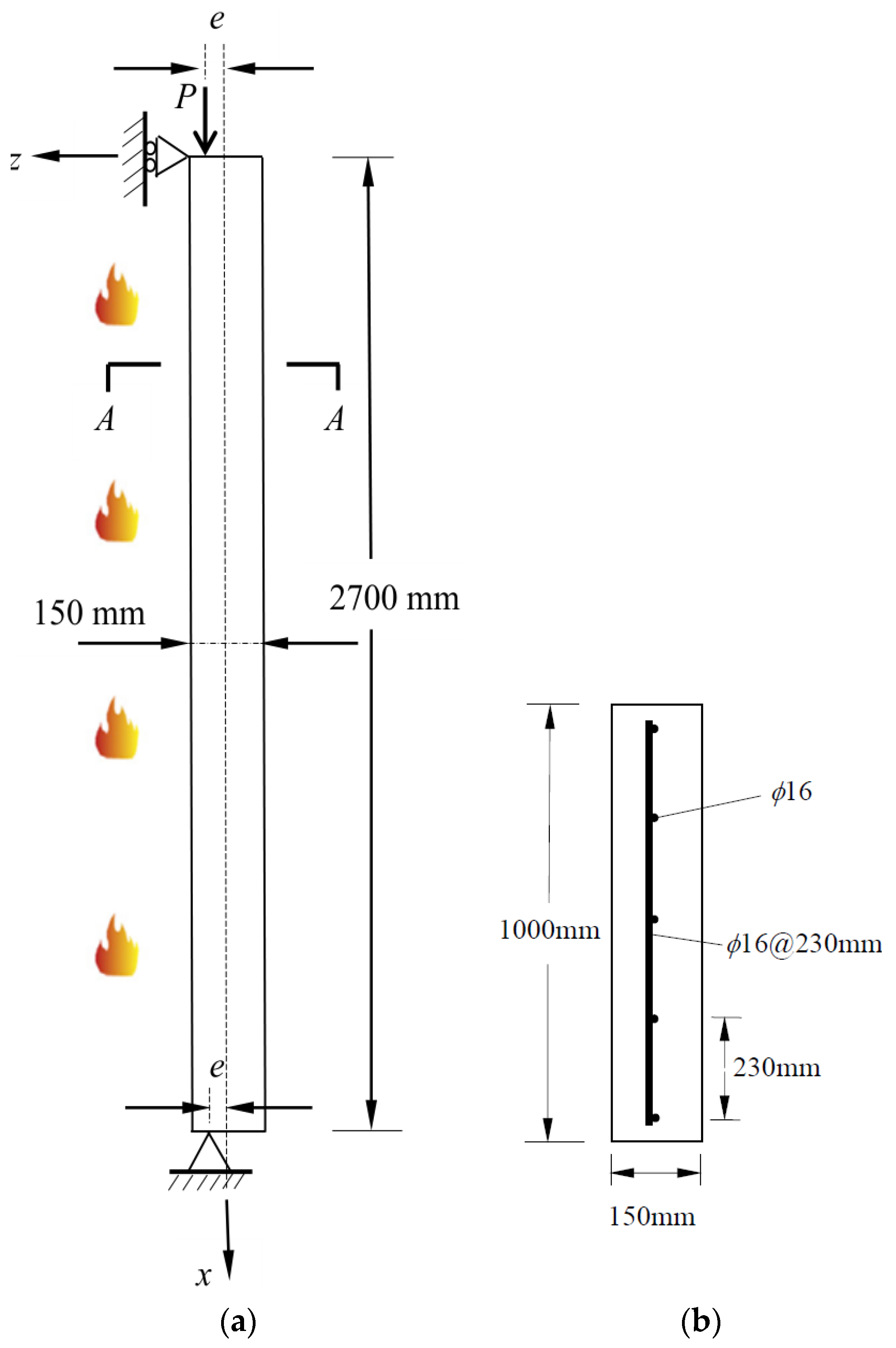


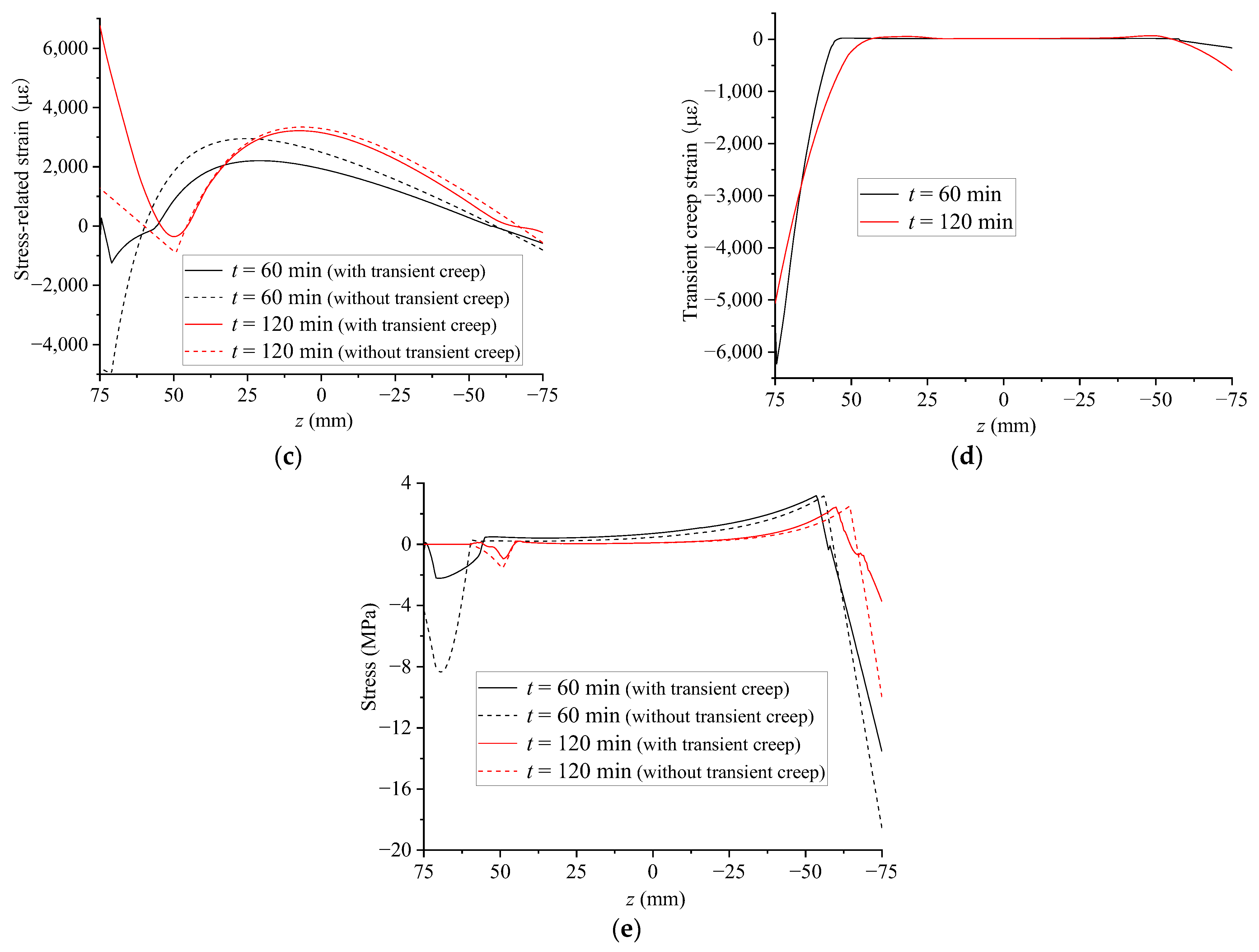
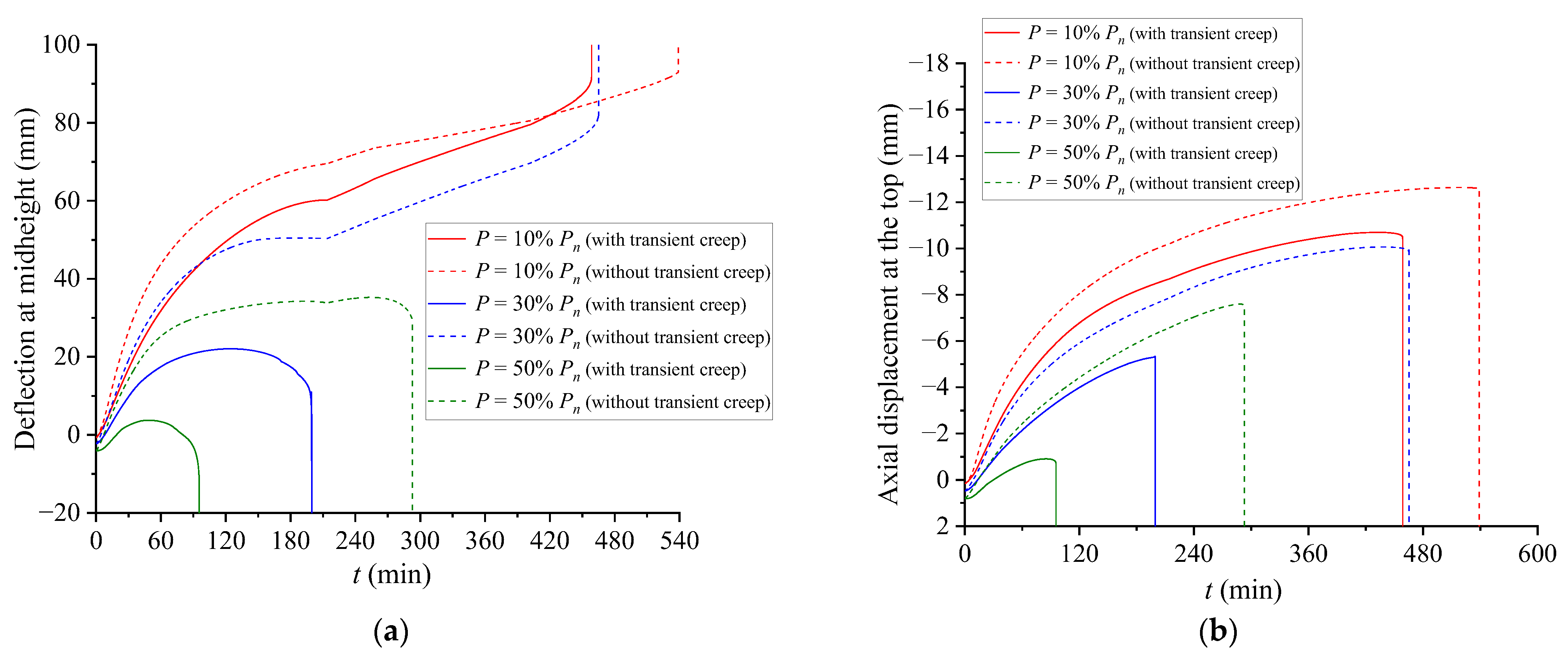

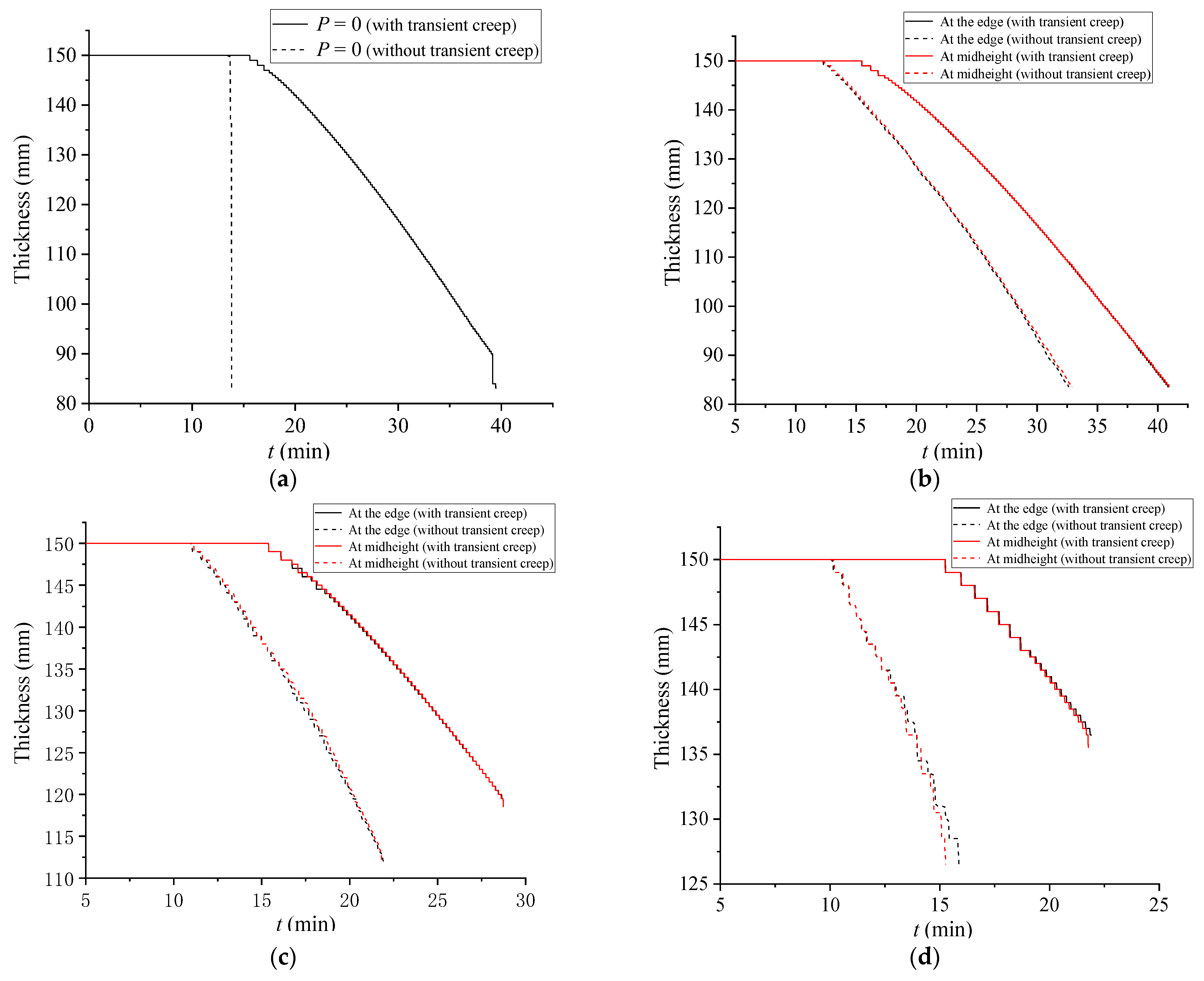


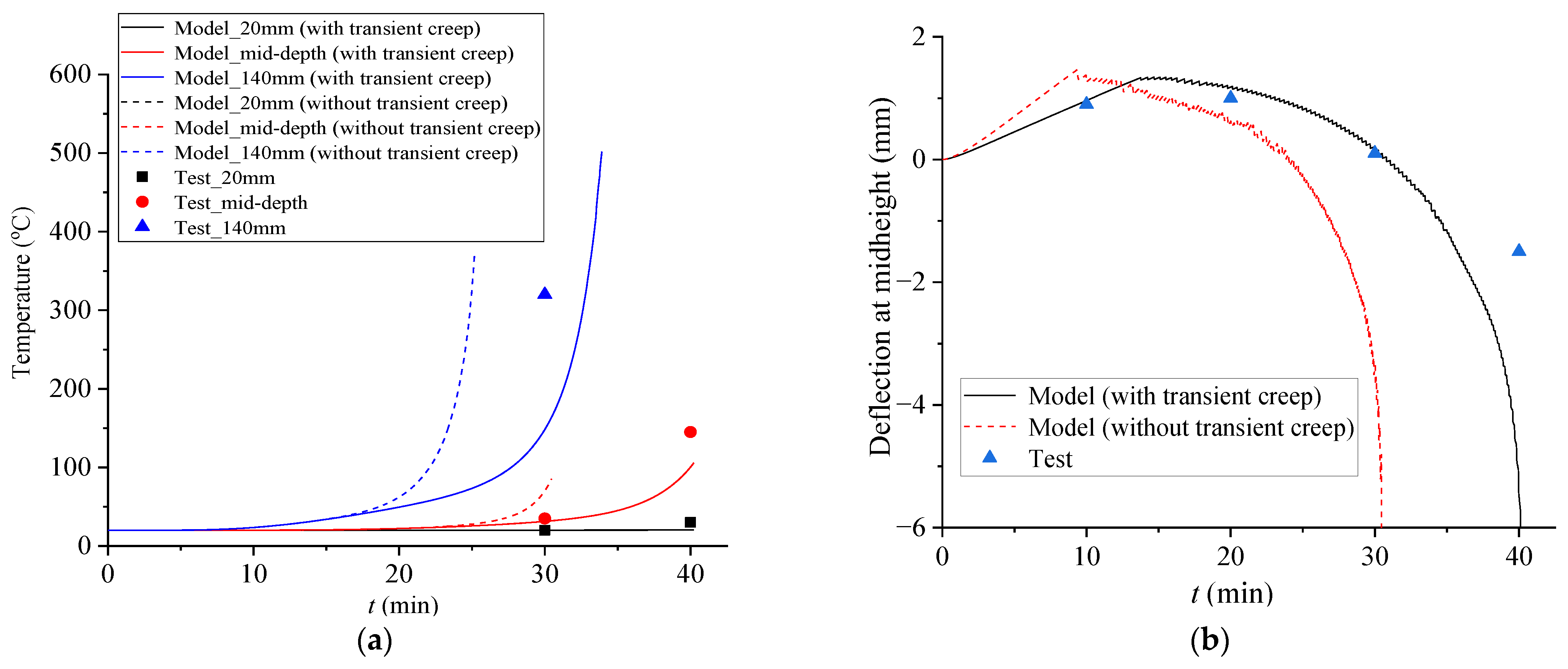

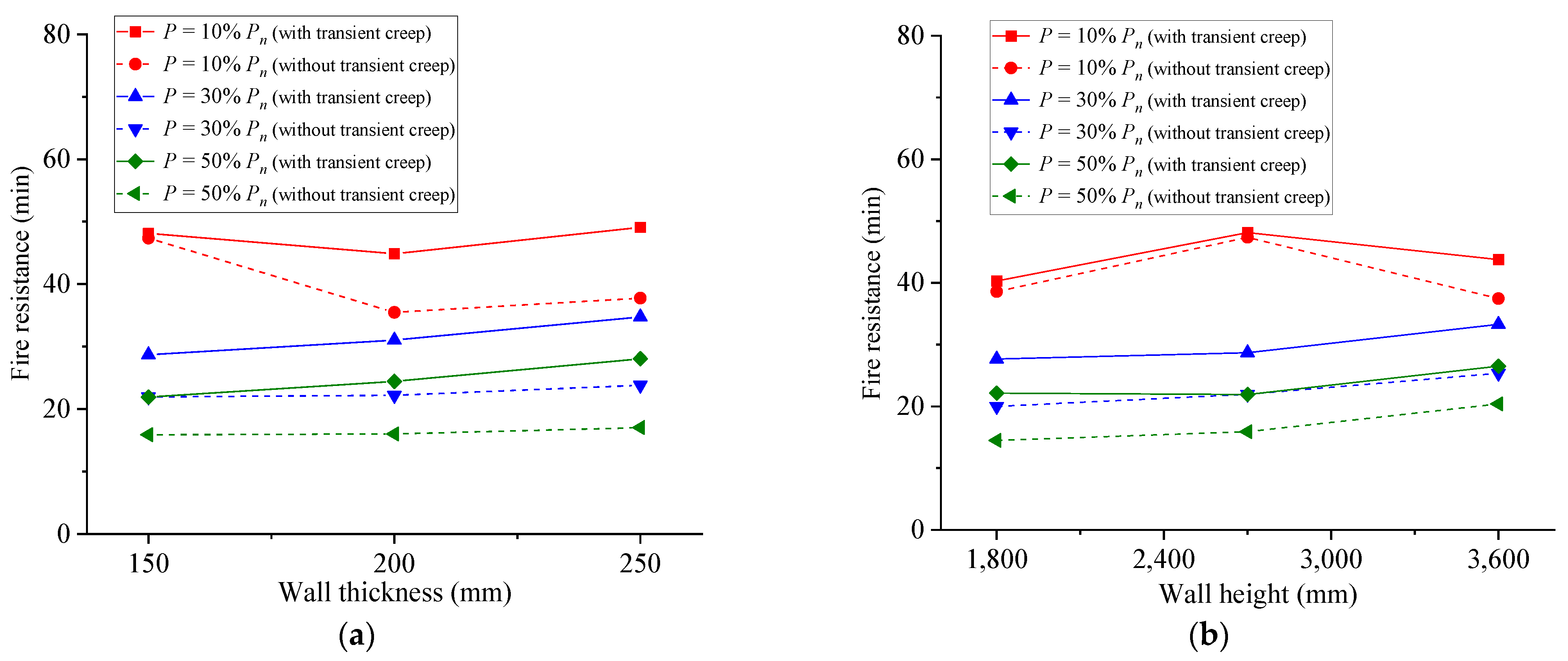

Disclaimer/Publisher’s Note: The statements, opinions and data contained in all publications are solely those of the individual author(s) and contributor(s) and not of MDPI and/or the editor(s). MDPI and/or the editor(s) disclaim responsibility for any injury to people or property resulting from any ideas, methods, instructions or products referred to in the content. |
© 2024 by the author. Licensee MDPI, Basel, Switzerland. This article is an open access article distributed under the terms and conditions of the Creative Commons Attribution (CC BY) license (https://creativecommons.org/licenses/by/4.0/).
Share and Cite
Chen, J. Effect of Transient Creep on the Structural Performance of Reinforced Concrete Walls under Fire. Buildings 2024, 14, 406. https://doi.org/10.3390/buildings14020406
Chen J. Effect of Transient Creep on the Structural Performance of Reinforced Concrete Walls under Fire. Buildings. 2024; 14(2):406. https://doi.org/10.3390/buildings14020406
Chicago/Turabian StyleChen, Jun. 2024. "Effect of Transient Creep on the Structural Performance of Reinforced Concrete Walls under Fire" Buildings 14, no. 2: 406. https://doi.org/10.3390/buildings14020406
APA StyleChen, J. (2024). Effect of Transient Creep on the Structural Performance of Reinforced Concrete Walls under Fire. Buildings, 14(2), 406. https://doi.org/10.3390/buildings14020406




